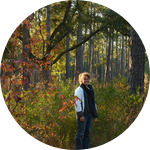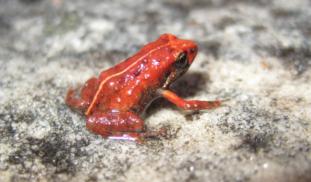Finding Fynbos Frogs
On July 9, John, Debra (a visiting student from University of Queensland Australia), Andrew Turner and I went to Caledon to sample for moss frogs, Arthroleptella rugosa. The species was recently described in 2008 and Andrew had found only a handful of populations, and only on this one mountain. Debra is interested in resurveying and quantifying population densities using an acoustic recording technique (which I'll also be using at my sites).

View of the Hottentots-Holland mountains
It was chilly in the morning when we met in front of the department building at 8am. The others met me with the "bakkie" (a pickup truck) and we loaded our gear and the acoustic recording equipment into the back. Then we headed southeast for Caledon.
We sped off past Somerset West and began to gain altitude as we drove into the Hottentots-Holland mountains.They loomed dark in front of us, shrouded in grey misty clouds while the valley behind and below us shone in the sun of a clear winter's day. As we gained elevation and the road turned, we could look below on a spectacular view of the city and False Bay.On either side of us the mountains were covered in fynbos.

We spun off down N2. It was amazing to see how the landscape varied quite conspicuously as we drove along.We passed mountains slopes of fynbos interspersed with dark patches of dense pines, or wrecked tracts of land invaded by eucalypts, and areas cleared but not re-treated by any follow-up work so the re-invasion is evident.Land varied in condition even within just a small area.

See the isolated alien trees interspersed across the landscape
Andrew and John explained how the land ownership of these invaded lands often becomes complicated, and it is often unclear who is responsible for managing it. Many times Cape Nature (analogous to USA state parks) is invoked to manage the land but there is only so much land that Cape Nature can handle so they must focus their resources on tracts with the greatest restoration potential. And so in such ambiguous cases, if nothing is done the land often becomes reinvaded.
We passed a slope of dense pines from which plumes of smoke billowed into the air and an occasional orange flame flickered through the trees.John remarked that people may cut the pines on their land and burn the slash.Prescribed fire is not so common as a land management tool, but such fires are an influence on the landscape insofar as they can get out of control during the summer fire season. So much of the Western Cape burns through natural wildfires that prescribed fires influence the fire regime primarily by increasing frequency, which is actually detrimental to fynbos.

Fynbos-covered slopes. See some pines off to the left side of the picture.
We zipped through the pass.On the mountains in this area one might be lucky to hear populations of Arthroleptella landdrosia. Then we headed down the slopes.We passed townships where isolated eucalypts stood as embarrassed aliens in a gutted landscape populated with corrugated shacks.Townships often sprung up and expanded with the infrastructure lagging far behind, leaving the inhabitants in shameful living conditions.
As we finished our descent into the lowland it was astonishing to see the abrupt transition from mountain slopes of fynbos to transformed renosterveld.

Renosterveld is a lowland fynbos type, very speciose in geophytes, but now severely endangered by agricultural land conversion.Flat sheep and cattle ranges spread wide on either side of the road, right up to the foot of the mountains.And even on these mountain slopes one could see alien pine forests.I asked Andrew if there were renosterveld restoration efforts going on and were they successful?Andrew replied that it was virtually impossible to restore renosterveld, so the focus is primarily on conserving remnant fragments.As much of the Western Cape is in private ownership, landowners have incentives such as tax breaks to protect renosterveld on their lands and refrain from converting it for farming.
Our destination mountain was in the hands of a private landowner whom we met at his place just off the highway N2.I have to admit that I do love hearing people speak Afrikaans, I think it's a beautiful language!I have been told that those who know both English and Afrikaans speak in the language most comfortable for them.Often for rural landowners this language is Afrikaans.A friend who has many farmers as clients told me, "Sometimes I will call them up and greet them in English.They'll then reply: 'Sorry I have used up my English for the week!'"
We opened the gate just off the highway and drove in through converted renosterveld.Here it was misty and chilly, so the water lay as a spray all over the different fynbos forms: restioids, proteas, ericas.It was a thrill to enter the world I had formerly seen only on the internet or in books.Now before me lived those various forms and colors in real life!

Heading for the first population site. See the narrow seep in the top right corner.
We bumped over the rutted road, higher and higher.Below us was a spectacular view of the valley.The grey cloud above us cast a shadow over the mountain but in the distance we could see the sunny fields spread out to the bay.

Finally we stopped next to the first of five or six known population sites.The area had been heavily invaded by pines and hakeas, but after a fire burned through in January 2012, Working for Water teams came through and cut and removed the adult invaders. Sadly, we could still see young pine and hakea seedlings creeping through the fynbos vegetation that had bounced back.
We got out of the cars and John said, "Wow, you can really hear them calling here."
We stood in the misty fog and I eagerly tried to process all the sounds on the mountain to identify what I was hearing.Which sound were the frogs?
"The clicking; you can hear the cr-r-riiick," John said.
Then it sonically materialized.Suddenly I heard them all around me, invisibly clicking in the restioid vegetation.To our right on the slope was the rushing water of the seep near which we stood.Andrew was pleased there were so many calling just a few years after the fire.Behind us on the mountain slopes we could also hear the hollow whistle-peeps of the Cape Rain frog.I reflected that the moss frogs sounded like our southern cricket frogs, and the cape rain frog sounded like one of the flutey whistles of the bird-voiced treefrog.They said the banded stream frog was also calling but I couldn't hear it.This frog has long limbs that allow it to scramble over tall vegetation without touching the ground!
It was time to set up our microphone array.Andrew and Debra walked around the area in which the frogs were calling to identify the center.Six microphones would be attached to stakes and connected to a central recording device.The recorder would be in the center and the stakes put out at various distances and directions.Then we would record for 40 minutes and finally measure the distances between all pairs of microphones.
It was challenging to work in the tall vegetation, which was pretty much over my head.You would just have to hack your way through the reeds and sometimes step on top of them like a thick mat to get to a microphone.This was also the case when measuring the distances.We frequently had to snap a tall dead hakea stem to get it out of the way of the measuring tape.

It was cold on the mountain.As we stood around waiting for the recording to finish, I poked around to see some of the flowers.The Mimetes was a stunning red, and there was a small bluish-purple lobelia amidst the brackenfern.So many forms in such a small area!I couldn't help anticipating spring when the mountain slopes should be bursting with color.




Measuring distances between microphones
When we finished this location we drove up higher to the next site.It was much easier to walk around, but quite rocky—a herper's rock-flipping paradise indeed!Andrew couldn't resist turning over rocks "that the baboons hadn't turned over already," he said.Baboons?!
We clambered over felled burned pines and scrambled amidst the seedlings down to the seep to listen.We didn't record here although the frogs were calling, but proceeded to an even higher site where we could get a recording done in time to head home before dark.

Pine seedlings

Felled, burned invaders
It was quite chilly on the mountain but wonderful to know that the populations are still there. In the coming weeks Debra will be acoustically monitoring more populations to update our knowledge on how the are affected by processes around them, including invasive species and fire.









1 comments